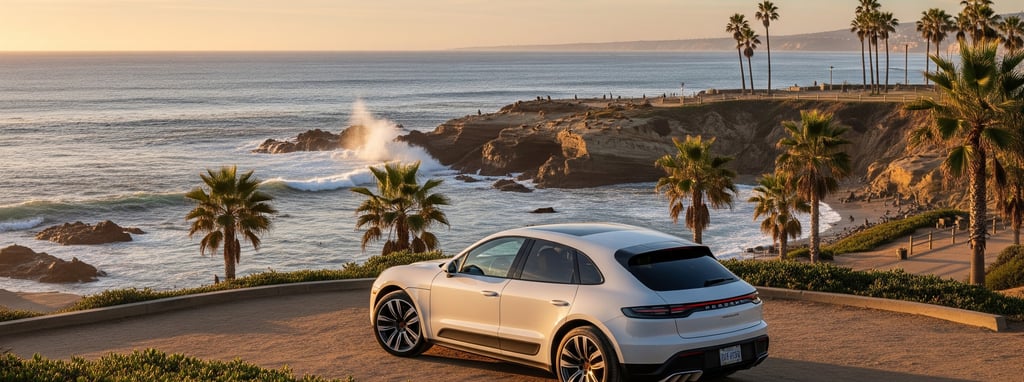
Understanding Residual Values and Money Factors in Los Angeles Car Leasing
Leasing a car in Los Angeles can be a smart move, but only if you understand the two numbers that matter most: residual value and money factor. We break down how they work, why LA drivers often get better deals, and the insider strategies manufacturers use to make leases more attractive. Learn how to spot a genuinely good lease before you sign.
7/29/20254 min read
Most shoppers fixate on the monthly payment. The smarter move is to understand the two numbers that drive it. Residual value and money factor. In a competitive market like Los Angeles, knowing how these work can turn a decent offer into a great one.
Why the Los Angeles market is a prime place to lease
Los Angeles, Orange County, and the Inland Empire form one of the deepest inventory pools in the country. The luxury and EV segments are especially competitive. More dealers mean more choice, more incentives, and more room to compare programs. That competition often shows up as stronger lease support and better availability of the exact trim and color you want.
Start with residual value
Residual value is the lender's estimate of what the vehicle will be worth at the end of the term, based on standard mileage and normal wear and tear. It is stated in the contract and expressed as a percentage of MSRP. It is not based on your negotiated selling price.
A higher residual means less depreciation to pay during the term, so the payment drops. A lower residual means you are paying for more depreciation, so the payment rises.
Most consumer leases are closed-end. That means you can return the vehicle at term and walk away, or you can purchase it for the residual price listed in your agreement. In other words, the residual is also your lease-end purchase option, subject to any fees in the contract.
SUV versus sedan, and why used market demand matters
Used buyers in the last decade have favored crossovers and SUVs. That demand supports stronger residuals for many utility vehicles versus comparable sedans. All else equal, a fifty thousand dollar SUV at a sixty percent residual will usually cost less per month than a fifty thousand dollar sedan at a fifty-two percent residual. The same logic explains why many Asian brands with strong resale often produce lower payments than similar domestic models that depreciate faster. The market reality of used values shows up directly in the lease payment.
A quick way to feel the math
Small changes in residuals move the needle more than people expect.
On a fifty thousand dollar MSRP, a three point higher residual is about one thousand five hundred dollars more value at lease end.
Spread over thirty six months, that alone is about forty two dollars per month less in depreciation, before you even look at interest or discounts.
The quiet tug of war inside every manufacturer
There is a natural tension between the sales organization and the captive finance arm. Sales wants lower finance costs and higher residuals to move units. Finance will own the returned cars and does not want to overestimate values. The final program you see is the compromise. In large, high-visibility markets like Los Angeles, sales often win more support because moving volume here is strategic.
BMW serves as a useful example of how strategy supports leasing without manipulating numbers. For years, BMW has built a strong certified pre-owned (CPO) program. Off-lease cars go directly into the CPO inventory and sell quickly. This cycle creates consistent demand at resale, which initially supports healthy residual values and helps maintain the attractiveness of lease programs.
Another lever is lease only support. It is common to see a manufacturer add more incentive money on a lease than on a purchase. In one well known case, a brand offered thousands more in lease support than purchase cash to move volume while protecting used values. Lease support helps the payment without showing up as a deep discount that could drag down resale prices across the market.
Money factor explained in plain English
The money factor is the finance charge on a lease. Multiply it by two thousand four hundred to estimate an APR. For example, a money factor of zero point zero zero one two five is about three percent APR. Lower is better. Captive lenders set promotional money factors and then apply credit tiers. Well qualified applicants get the promotional rate. If your score is below the top tier, the factor can rise and the payment follows. Two shoppers who see the same ad may not qualify for the same rate.
Even a small change matters. On a mid priced luxury SUV, a difference of zero point zero zero zero five in the money factor can add or subtract hundreds of dollars over the full term.
Wear, tear, mileage, and the Los Angeles reality
Normal wear and tear is baked into the residual. That covers light scuffs, small scratches, and expected tire wear. Excess wear is charged at turn in. In Los Angeles, curb rash on expensive wheels is common, and bent rims from potholes are not considered normal. Plan for a pre turn in inspection so you know where you stand.
Mileage matters because it changes what the vehicle is worth at term. If you routinely drive more than the standard allowance, consider a higher mileage program up front. It is usually cheaper than paying overage later.
Most closed end leases include a disposition fee if you return the vehicle. That fee is separate from any excess wear or mileage charges. If you buy the vehicle at term, many brands waive the disposition fee.
What really decides a good lease
Forget the noise. Four items do the heavy lifting.
Residual value as a percent of MSRP
Negotiated selling price and any cap cost reductions or rebates
Money factor based on your credit tier
Lease only incentives that do not exist on a purchase
Everything else just arranges these four to fit your budget and your driving.
If you expect to buy the vehicle at term, the residual matters twice. It shapes your payment today and becomes your purchase price later. If you are sure you will not keep it, focus on total drive off cost, monthly payment, money factor, and the mileage allowance that matches your life.
Why leasing is popular in Los Angeles
Los Angeles drivers value flexibility and comfort. A lease lets you change course without listing and selling a car. New job in the mountains. New hobby that requires all wheel drive. Growing family that needs a third row. At term you can pivot without friction. Daily life here also means real seat time. Newer seats, fresh tech, and better driver assistance make long commutes easier. For many Angelenos that comfort has value.
How we can help
We track current programs across the Los Angeles market and compare offers from multiple dealers. We break down residuals, money factors, incentives, and true drive off costs so you can see exactly where the value is. If you want a second set of eyes, send us the quote. We will tell you in plain language whether it is strong, average, or padded.
Ready to shop smart. See some of our recent deals that have caught our attention and contact us to review numbers before you sign. One conversation can save you real money over the next thirty-six months.


Don't Lease a Car in Los Angeles Without Us!
Contact Us
© 2025. CarOracle LLC DBA Los Angeles Lease Deals. All rights reserved.


